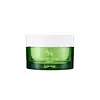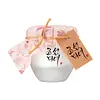What's inside
What's inside
 Key Ingredients
Key Ingredients

 Benefits
Benefits

 Concerns
Concerns

 Ingredients Side-by-side
Ingredients Side-by-side

Melaleuca Alternifolia Leaf Extract
PerfumingButylene Glycol
HumectantGlycerin
HumectantGlyceryl Stearate
Emollient1,2-Hexanediol
Skin ConditioningCyclopentasiloxane
EmollientCaprylic/Capric Triglyceride
MaskingEthylhexyl Stearate
EmollientCetyl Ethylhexanoate
EmollientBetaine
HumectantEthyl Hexanediol
SolventSodium Polyacrylate
AbsorbentPEG-100 Stearate
Cetearyl Glucoside
EmulsifyingCetearyl Alcohol
EmollientPalmitic Acid
EmollientStearic Acid
CleansingPolyacrylate-13
Xanthan Gum
EmulsifyingPanthenol
Skin ConditioningEthylhexylglycerin
Skin ConditioningPolyisobutene
Potassium Hydroxide
BufferingLavandula Angustifolia Oil
MaskingWater
Skin ConditioningPolysorbate 20
EmulsifyingMelaleuca Alternifolia Leaf Oil
AntioxidantSorbitan Isostearate
EmulsifyingMyristic Acid
CleansingHippophae Rhamnoides Extract
MaskingThymus Vulgaris Flower/Leaf Extract
MaskingBuddleja Davidii Extract
Skin ConditioningCentella Asiatica Extract
CleansingHamamelis Virginiana Water
AstringentMelaleuca Alternifolia Leaf Extract, Butylene Glycol, Glycerin, Glyceryl Stearate, 1,2-Hexanediol, Cyclopentasiloxane, Caprylic/Capric Triglyceride, Ethylhexyl Stearate, Cetyl Ethylhexanoate, Betaine, Ethyl Hexanediol, Sodium Polyacrylate, PEG-100 Stearate, Cetearyl Glucoside, Cetearyl Alcohol, Palmitic Acid, Stearic Acid, Polyacrylate-13, Xanthan Gum, Panthenol, Ethylhexylglycerin, Polyisobutene, Potassium Hydroxide, Lavandula Angustifolia Oil, Water, Polysorbate 20, Melaleuca Alternifolia Leaf Oil, Sorbitan Isostearate, Myristic Acid, Hippophae Rhamnoides Extract, Thymus Vulgaris Flower/Leaf Extract, Buddleja Davidii Extract, Centella Asiatica Extract, Hamamelis Virginiana Water
Water
Skin ConditioningGlycerin
HumectantButylene Glycol
HumectantNiacinamide
SmoothingDipentaerythrityl Hexa C5-9 Acid Esters
Skin ConditioningSodium Hyaluronate
HumectantXanthan Gum
EmulsifyingCyclopentasiloxane
EmollientCyclohexasiloxane
EmollientPolyacrylate-13
Polyisobutene
Polysorbate 20
EmulsifyingHydrogenated Lecithin
EmulsifyingC14-28 Alkyl Acid
Stearyl Alcohol
EmollientBehenyl Alcohol
EmollientDimethicone/Vinyl Dimethicone Crosspolymer
Skin ConditioningDimethicone
EmollientAdenosine
Skin ConditioningGlyceryl Stearate Se
EmulsifyingCetearyl Alcohol
EmollientPolyglyceryl-3 Methylglucose Distearate
EmulsifyingCetyl PEG/PPG-10/1 Dimethicone
EmulsifyingStearic Acid
CleansingTocopheryl Acetate
AntioxidantSodium Polyacrylate
AbsorbentOlea Europaea Fruit Oil
MaskingHelianthus Annuus Seed Oil
EmollientCentella Asiatica Extract
CleansingHippophae Rhamnoides Oil
EmollientArgania Spinosa Kernel Oil
EmollientButyrospermum Parkii Butter
Skin ConditioningCeramide NP
Skin ConditioningTrehalose
HumectantCalendula Officinalis Flower Extract
MaskingCaprylhydroxamic Acid
1,2-Hexanediol
Skin ConditioningRaphanus Sativus Leaf Extract
HumectantOryza Sativa Bran Extract
Skin ConditioningCucurbitaceae Extract
Skin ConditioningOrchid Extract
Skin ConditioningHoney Extract
HumectantPanax Ginseng Root Extract
EmollientCarthamus Tinctorius Seed Oil
MaskingPhytosphingosine
Skin ConditioningCeteareth-20
CleansingGlyceryl Citrate/Lactate/Linoleate/Oleate
EmulsifyingParfum
MaskingWater, Glycerin, Butylene Glycol, Niacinamide, Dipentaerythrityl Hexa C5-9 Acid Esters, Sodium Hyaluronate, Xanthan Gum, Cyclopentasiloxane, Cyclohexasiloxane, Polyacrylate-13, Polyisobutene, Polysorbate 20, Hydrogenated Lecithin, C14-28 Alkyl Acid, Stearyl Alcohol, Behenyl Alcohol, Dimethicone/Vinyl Dimethicone Crosspolymer, Dimethicone, Adenosine, Glyceryl Stearate Se, Cetearyl Alcohol, Polyglyceryl-3 Methylglucose Distearate, Cetyl PEG/PPG-10/1 Dimethicone, Stearic Acid, Tocopheryl Acetate, Sodium Polyacrylate, Olea Europaea Fruit Oil, Helianthus Annuus Seed Oil, Centella Asiatica Extract, Hippophae Rhamnoides Oil, Argania Spinosa Kernel Oil, Butyrospermum Parkii Butter, Ceramide NP, Trehalose, Calendula Officinalis Flower Extract, Caprylhydroxamic Acid, 1,2-Hexanediol, Raphanus Sativus Leaf Extract, Oryza Sativa Bran Extract, Cucurbitaceae Extract, Orchid Extract, Honey Extract, Panax Ginseng Root Extract, Carthamus Tinctorius Seed Oil, Phytosphingosine, Ceteareth-20, Glyceryl Citrate/Lactate/Linoleate/Oleate, Parfum
Alternatives
Ingredients Explained
These ingredients are found in both products.
Ingredients higher up in an ingredient list are typically present in a larger amount.
1,2-Hexanediol is a synthetic liquid and another multi-functional powerhouse.
It is a:
- Humectant, drawing moisture into the skin
- Emollient, helping to soften skin
- Solvent, dispersing and stabilizing formulas
- Preservative booster, enhancing the antimicrobial activity of other preservatives
Butylene Glycol (or BG) is used within cosmetic products for a few different reasons:
Overall, Butylene Glycol is a safe and well-rounded ingredient that works well with other ingredients.
Though this ingredient works well with most skin types, some people with sensitive skin may experience a reaction such as allergic rashes, closed comedones, or itchiness.
Learn more about Butylene GlycolCentella Asiatica Extract (Centella) is derived from an herb native to Southeast Asia. It is famous for its anti-inflammatory and soothing properties.
Centella is rich in antioxidants and amino acids, such as Madecassic Acid and Asiaticoside.
Studies show the compounds in centella help with:
The combination of all these properties makes centella effective at soothing, hydrating, and protecting the skin.
Other great components of centella include Vitamin A, vitamin C, several B vitamins, and Asiatic Acid.
Fun fact: Centella has been used as a medicine and in food for many centuries. As a medicine, it is used to treat burns, scratches, and wounds.
Learn more about Centella Asiatica ExtractCetearyl alcohol is a mixture of two fatty alcohols: cetyl alcohol and stearyl alcohol. It is mainly used as an emulsifier. Emulsifiers help prevent the separation of oils and products. Due to its composition, it can also be used to thicken a product or help create foam.
Cetearyl alcohol is an emollient. Emollients help soothe and hydrate the skin by trapping moisture.
Studies show Cetearyl alcohol is non-toxic and non-irritating. The FDA allows products labeled "alcohol-free" to have fatty alcohols.
This ingredient is usually derived from plant oils such as palm, vegetable, or coconut oils. There is debate on whether this ingredient will cause acne.
Due to the fatty acid base, this ingredient may not be Malassezia folliculitis safe.
Learn more about Cetearyl AlcoholCyclopentasiloxane, or D5, is a silicone used to improve texture of products and trap moisture.
D5 is considered lightweight and volatile. Volatile means it evaporates quickly after application. Once evaporated, D5 leaves a thin barrier that helps keep skin hydrated.
It is also an emollient. Emollients help soften the skin and prevent water loss. Silicones create a silky texture in products. D5 helps other ingredients become more spreadable.
Studies show D5 is safe to use in skincare products. We recommend speaking with a skincare professional if you have concerns.
Learn more about CyclopentasiloxaneGlycerin is already naturally found in your skin. It helps moisturize and protect your skin.
A study from 2016 found glycerin to be more effective as a humectant than AHAs and hyaluronic acid.
As a humectant, it helps the skin stay hydrated by pulling moisture to your skin. The low molecular weight of glycerin allows it to pull moisture into the deeper layers of your skin.
Hydrated skin improves your skin barrier; Your skin barrier helps protect against irritants and bacteria.
Glycerin has also been found to have antimicrobial and antiviral properties. Due to these properties, glycerin is often used in wound and burn treatments.
In cosmetics, glycerin is usually derived from plants such as soybean or palm. However, it can also be sourced from animals, such as tallow or animal fat.
This ingredient is organic, colorless, odorless, and non-toxic.
Glycerin is the name for this ingredient in American English. British English uses Glycerol/Glycerine.
Learn more about GlycerinPolyacrylate-13 is a type of acrylate polymer. Acrylate polymers are commonly used as adhesives in cosmetics.
Polyacrylate-13 creates a film to protect the skin. It is also used to thicken and stabilize a product. It works by making water a gel-like consistency. This gel consistency helps suspend particles.
Polyacrylate-13 is a copolymer of acrylic acid, acrylamide, sodium acrylate, sodium acryloyldimethyltaurate monomers
Learn more about Polyacrylate-13Polyisobutene is a synthetic polymer made from isobutene.
It is a film-forming agent and helps bind ingredients together.
Polyisobutene is not absorbed by the skin.
Learn more about PolyisobutenePolysorbate 20 is made by combining ethoxylation of sorbitan, ethylene oxide, and lauric acid. It is a mild cleansing agent, surfactant, and emulsifier.
As a surfactant, it helps collect dirt and oils for washing. Emulsifiers prevent oils and water from separating.
Polysorbate 20 also adds scent to a product. Since it is made using sorbitol, it has a sweet scent. Sorbitol can also be found in fruits such as apples and peaches.
The lauric acid used to create Polysorbate 20 is often derived from coconuts.
Polysorbate 20 may not be fungal acne safe.
Learn more about Polysorbate 20Sodium Polyacrylate is the sodium salt of polyacrylic acid. It is used as an absorber, emollient, and stabilizer.
This ingredient is a super-absorbent polymer - meaning it can absorb 100 to 1000 times its mass in water. As an emollient, Sodium Polyacrylate helps soften and soothe skin. Emollients work by creating a barrier to trap moisture in. This helps keep your skin hydrated.
Stearic Acid is a fatty acid. It is an emollient, emulsifier, and texture enhancer.
As an emollient, stearic acid helps soften skin. It aids the skin's protective barrier by preventing water loss. It also provides a gentle cleansing effect without stripping away natural oils.
Stearic acid may also be used to enhance the texture of products. It can add volume and stabilize ingredients such as water and oil. This can help water and oil ingredients from separating.
Sources of stearic acid include animal or vegetable fats/oils such as coconut or shea. It can be naturally found in butter, cocoa butter, shea butter, vegetable fats, and animal tallow.
This ingredient may not be Malassezia folliculitis, or fungal-acne safe.
Learn more about Stearic AcidWater. It's the most common cosmetic ingredient of all. You'll usually see it at the top of ingredient lists, meaning that it makes up the largest part of the product.
So why is it so popular? Water most often acts as a solvent - this means that it helps dissolve other ingredients into the formulation.
You'll also recognize water as that liquid we all need to stay alive. If you see this, drink a glass of water. Stay hydrated!
Learn more about WaterXanthan gum is used as a stabilizer and thickener within cosmetic products. It helps give products a sticky, thick feeling - preventing them from being too runny.
On the technical side of things, xanthan gum is a polysaccharide - a combination consisting of multiple sugar molecules bonded together.
Xanthan gum is a pretty common and great ingredient. It is a natural, non-toxic, non-irritating ingredient that is also commonly used in food products.
Learn more about Xanthan Gum